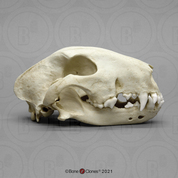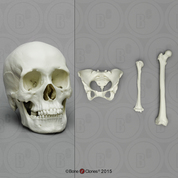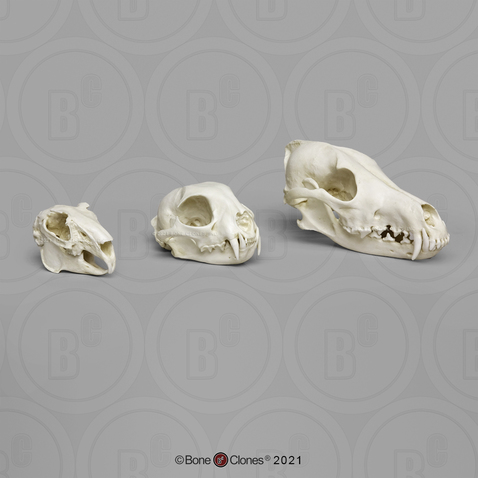-
Fields of Study
- K-12 Education
- Advanced Anatomy
- Forensics
- Physical Therapy
- Primate Locomotion
- Non-primate Locomotion
- Biological Anthropology
- Paleontology
- Bioarchaeology
- Marine-Aquarium
- Veterinary
-
Zoology
- All Zoological Items
- Endangered Species
- Skulls
- Skeletons
- Cranial Elements
- Postcranial Elements
- Eggs
- Limbs
- Teeth & Fangs
- Claws & Talons
- Brains & Endocasts
- Life Casts
- Pathology & Trauma
- Wildlife Forensics
- Sets
- Bird Sets
- Accessories
- Birds
- Mammals
- Reptiles & Amphibians
- Fish
- Sharks & Rays
- Turtles & Tortoises
- Anatomy for the Artist
- Decor
- Veterinary
- Elements
- Pathology & Trauma
-
Sets & Series
- Natural History Gift Ideas
- Decor
- Scale & Sculpture
- 3D Scanned & Printed
- Bone Boxes
- Locomotion Sets
- Forensic Sets
- Advanced Anatomy Sets
- Physical Therapy Series
- Fetal Sets
- Economy Series
- Zoology Sets
- Bird Sets
- Claw & Talon Sets
- Tooth & Fang Sets
- Primate Skull Sets
- Fossil Hominid Sets
- B.I.O.P.S.I. - Babiarz Institute
- Maxwell Collection
- Bergdorf Goodman Windows
- Accessories
- New Products
-
Our Company
- News & Specials
- Printable Handouts
- About Us
- Why Choose Bone Clones
- Bone Clones in the News
- Mission
- Contact Us
- Privacy and Security
- Frequently Asked Questions
- Testimonials
- Community Outreach
- Legal/Copyright
- Flyers
- Choosing Original Specimens
- Museum Exhibitions
- Natural History Gift Ideas
- About the Economy Series
- Acknowledgements
- Ordering & Delivery
- Warranty
- Refund/Return Policy
- Price List at a Glance
- Our Catalog
- Osteological Evaluation Reports
- About 3D Printing
- Sawyer & Maley Neanderthal Reconstruction
- Site Introduction
- Newsletter Archive
-
Human Anatomy
- All Human Anatomy
- Human Skulls
- Human Skeletons
- Head & Neck
- Postcranial Elements
- Advanced Anatomy
- Physical Therapy / Joints
- Human Brains & Endocast
- Human Life Casts
- Maxwell Museum
- Sets & Series
- Accessories
- Osteological Evaluation Reports
- Featured
- Adult Human Anatomy
- Adolescent Human Anatomy
- Child Human Anatomy
- Fetal Human Anatomy
- Fossil Hominids
-
Zoology
- All Zoological Items
- Endangered Species
- Skulls
- Skeletons
- Cranial Elements
- Postcranial Elements
- Eggs
- Limbs
- Teeth & Fangs
- Claws & Talons
- Brains & Endocasts
- Life Casts
- Pathology & Trauma
- Wildlife Forensics
- Sets
- Bird Sets
- Accessories
- Birds
- Mammals
- Reptiles & Amphibians
- Fish
- Sharks & Rays
- Turtles & Tortoises
- Paleontology
- Non-human Primates
- Forensics
All items sold on this website are replicas and are 1:1 scale unless stated otherwise. All Bone Clones® products are made in the USA. No real/natural bone is available on this site.
- Comp ,
- Economy ,
- predator ,
- Prey ,
- veterinary
 ALSO SEE:
ALSO SEE:
Dietary Comparison Economy Skull Set
Canid Comparison Economy Skull Set
Predator - Prey Comparison Economy Skull Set
COMP-142 $268.00
Predator or prey? Can you tell by looking at an animal which it is?
A skull's features can provide clues as to whether its owner was a predatory or preyed upon animal. Its size, dentition (form and number of teeth) and eye socket position contribute pieces of information that help with classification. Dentition contributes information about how and what an animal eats. Eye orientation and position vary according to what role eyesight plays in an animal's life.
This comparative set of three mammal skulls was created to demonstrate the key features that help to determine if an animal is a predatory animal or a preyed animal. This skull set contains a coyote, a bobcat and a jackrabbit, all with different skeletal features that highlight their dietary adaptations. Additionally, each animal can be compared to their prospective habitats, bringing into focus discussions of animal adaptation, animal behavior and environmental concepts.
In visual arts curriculum, this set can be used for students to analyze form and its depiction in drawing and sculpting, as material for still life compositions, and as comparative anatomical reference for student's own depictions of animals. These skulls can be used enrich student's knowledge as to how underlying form pertains to living animals, to compare historic and cultural uses of bone material for artistic purposes, and to teach about careers as scientific illustrators, film or fine artists.
This set can be useful in satisfying some of the national and state requirements of the Next Generation Science Standards (NGSS), The National Visual Arts Standards, and State Standards for Arts Education.
More About The Bone Clones® Economy Series
| Scientific Name | Catalogue # | Size | Price |
| Mammalia | COMP-142 | SET | $268.00 |
Related Products:
-
 Human Female Asian Economy Skull
Human Female Asian Economy Skull -
 Economy Domestic Cat Skull
Economy Domestic Cat Skull -
 Gray Fox Skull
Gray Fox Skull -
 Javelina Skull
Javelina Skull -
 Skull Trauma Set of Six Fragments
Skull Trauma Set of Six Fragments -
 Black-footed Ferret Skull
Black-footed Ferret Skull -
 White Bull Terrier Skull
White Bull Terrier Skull -
 Comparative Bird Skull Set of 3
Comparative Bird Skull Set of 3 -
 Economy Human Female African-American Comparative Set
Economy Human Female African-American Comparative Set -
 Barn Owl Set
Barn Owl Set -
 Roadrunner Skull and Foot Set
Roadrunner Skull and Foot Set -
 Sea Otter Skull
Sea Otter Skull -
 Tuatara Skull
Tuatara Skull -
 Dwarf Crocodile Skull
Dwarf Crocodile Skull -
 7 Inch Megalodon Shark Tooth
7 Inch Megalodon Shark Tooth
Newsletter Signup
9200 Eton Ave.
Chatsworth, CA 91311 USA
© 1992-2025 Bone Clones Holdings. All Rights Reserved.
Customer Service
© 2025 BONE CLONES HOLDINGS / Made by MEV


















